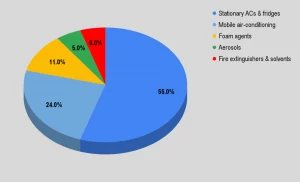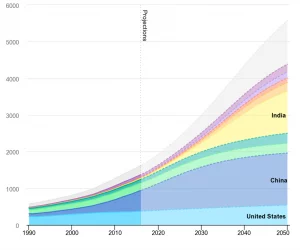ForumIAS announcing GS Foundation Program for UPSC CSE 2025-26 from 19 April. Click Here for more information.
ForumIAS Answer Writing Focus Group (AWFG) for Mains 2024 commencing from 24th June 2024. The Entrance Test for the program will be held on 28th April 2024 at 9 AM. To know more about the program visit: https://forumias.com/blog/awfg2024
Source: The post is based on the article “Global Cooling Pledge at COP28: How refrigerators and ACs contribute to global warming” published in “Indian Express” on 8th December 2023
Why in the News?
At the ongoing COP28 climate summit, 63 countries have signed the Global Cooling Pledge to drastically cut cooling emissions.
What is the Global Cooling Pledge?
1) Global Cooling Pledge was signed during the ongoing COP28 climate summit.
2) The pledge commits the countries to reduce their cooling emissions by at least 68% by 2050 and outlines several strategies to tackle them.
3) Signed by: 63 countries including the US, Canada and Kenya. India has not signed the pledge yet.
What are Cooling Emissions?
Cooling emissions are essentially emissions generated from refrigerants used in appliances like ACs and refrigerators and the energy used for cooling.
Sources of Cooling Emissions:

1) Refrigerants: In the past, most of the cooling appliances used chlorofluorocarbons (CFCs) as refrigerants. But it was found to be responsible for abnormally low ozone concentrations in Antarctica.
– As such, 1987 Montreal Protocol was signed to stop the production of ozone-depleting substances, including CFCs.
– CFCs were then replaced by hydrofluorocarbons (HFCs) and hydrochlorofluorocarbons (HCFCs). Although HFCs and HCFCs don’t damage the ozone layer, they are powerful greenhouse gases.
– In 2016, the Kigali Amendment to the Montreal Protocol was signed to reduce HFC consumption by 80% by 2047. If achieved, this could avoid more than 0.5 degree Celsius of global warming by 2100.
2) Cooling Appliances: Running cooling appliances requires electricity, which is often produced by burning fossil fuels. This releases additional greenhouse gases like CO2.
– Since 1990, the energy used for space cooling (the process of cooling indoors) has tripled and is expected to continue increasing significantly.
What is the contribution of cooling emissions to greenhouse gas emissions?

1) Cooling emissions currently account for about 7% of global greenhouse gas emissions.
2) But as global warming worsens, the demand for cooling will increase dramatically, which will create more warming in a destructive vicious cycle.
3) According to a report by the United Nations Environment Programme (UNEP) and the IEA, the number of global cooling devices is expected to jump from 3.6 billion to 9.5 billion by 2050.
UPSC Syllabus: Environment




